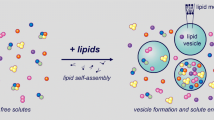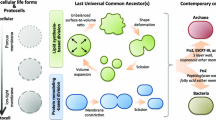Abstract
Following is a synthetic review on the minimal living cell, defined as an artificial or a semi-artificial cell having the minimal and sufficient number of components to be considered alive. We describe concepts and experiments based on these constructions, and we point out that an operational definition of minimal cell does not define a single species, but rather a broad family of interrelated cell-like structures. The relevance of these researches, considering that the minimal cell should also correspond to the early simple cell in the origin of life and early evolution, is also explained. In addition, we present detailed data in relation to minimal genome, with observations cited by several authors who agree on setting the theoretical full-fledged minimal genome to a figure between 200 and 300 genes. However, further theoretical assumptions may significantly reduce this number (i.e. by eliminating ribosomal proteins and by limiting DNA and RNA polymerases to only a few, less specific molecular species). Generally, the experimental approach to minimal cells consists in utilizing liposomes as cell models and in filling them with genes/enzymes corresponding to minimal cellular functions. To date, a few research groups have successfully induced the expression of single proteins, such as the green fluorescence protein, inside liposomes. Here, different approaches are described and compared. Present constructs are still rather far from the minimal cell, and experimental as well as theoretical difficulties opposing further reduction of complexity are discussed. While most of these minimal cell constructions may represent relatively poor imitations of a modern full-fledged cell, further studies will begin precisely from these constructs. In conclusion, we give a brief outline of the next possible steps on the road map to the minimal cell.





Similar content being viewed by others
Notes
The international meetings were the Third COST D27 Workshop held in Crete in October 2004 (http://cost.cordis.lu/src/action_detail.cfm?action=D27) and The International School on Complexity held in Erice, Sicily, in December 2004 (http://www.ccsem.infn.it). See also Szathmáry (2005).
One of the referees, whom we particularly thank for acute comments, suggested that it would be actually useful to define ‘a hierarchy of “minimal cells”. Some members of this hierarchy might require extensive resources from the environment, such as high-energy compounds. Others might be able to survive in a nutrient-poor environment, presumably more compatible with the “primordial soup”. In fact, it would be quite interesting to analyse the differences between different members; they would be quite revealing as far as the nature of life goes’. This proposal may indeed be the basis for future developments of this kind of work on the minimal cell, particularly when experimental data become available on these different classes of artificial protocells.
References
Bachmann PA, Luisi PL, Lang J (1992) Autocatalytic self-replicating micelles as models for prebiotic structures. Nature 357:57–59
Berclaz N, Mueller M, Walde P, Luisi PL (2001) Growth and transformation of vesicles studied by ferritin labeling and cryotransmission electron microscopy. J Phys Chem B 105:1056–1064
Bloechliger E, Blocher M, Walde P, Luisi PL (1998) Matrix effect in the size distribution of fatty acid vesicles. J Phys Chem 102:10383–10390
Calderone CT, Liu DR (2004) Nucleic-acid-templated synthesis as a model system for ancient translation. Curr Opin Chem Biol 8:645–653
Cello J, Paul AV, Wimmer E (2002) Chemical synthesis of poliovirus cDNA: generation of infectious virus in the absence of natural template. Science 297:1016–1018
Chakrabarti AC, Breaker RR, Joyce GF, Deamer DW (1994) Production of RNA by a polymerase protein encapsulated within phospholipid vesicles. J Mol Evol 39:555–559
Dyson FJ (1982) A model for the origin of life. J Mol Evol 18:344–350
Fischer A, Franco A, Oberholzer T (2002) Giant vesicles as microreactors for enzymatic mRNA synthesis. ChemBioChem 3:409–417
Fraser CM, Gocayne JD, White O, Adams MD, Clayton RA, Fleischmann RD, Bult CJ, Kerlavage AR, Sutton G, Kelley JM et al (1995) The minimal gene complement of Mycoplasma genitalium. Science 270:397–403
Frick DN, Richardson CC (2001) DNA primases. Annu Rev Biochem 70:39–80
Gavrilova LP, Kostiashkina OE, Koteliansky VE, Rutkevitch NM, Spirin AS (1976) Factor-free (non-enzymic) and factor-dependent systems of translation of polyuridylic acid by Escherichia coli ribosomes. J Mol Biol 101:537–552
Gil R, Sabater-Munoz B, Latorre A, Silva FJ, Moya A (2002) Extreme genome reduction in Buchnera spp: toward the minimal genome needed for symbiotic life. PNAS 99:4454–4458
Gil R, Silva FJ, Peretó J, Moya A (2004) Determination of the core of a minimal bacteria gene set. Microbiol Mol Biol Rev 68:518–537
Glade N, Demongeot J, Tabony J (2004) Microtubule self-organisation by reaction–diffusion processes causes collective transport and organisation of cellular particles. BMC Cell Biol 5:23. DOI 10.1186/1471-2121-5-23
Hutchinson CA, Peterson SN, Gill SR, Cline RT, White O, Fraser CM, Smith HO, Venter JC (1999) Global transposon mutagenesis and a minimal Mycoplasma genome. Science 286:2165–2169
Ishikawa K, Sato K, Shima Y, Urabe I, Yomo T (2004) Expression of a cascading genetic network within liposomes. FEBS Lett 576:387–390
Islas S, Becerra A, Luisi PL, Lazcano A (2004) Comparative genomics and the gene complement of a minimal cell. Orig Life Evol Biosph 34:243–256
Itaya M (1995) An estimation of the minimal genome size required for life. FEBS Lett 362:257–260
Jay D, Gilbert W (1987) Basic protein enhances the encapsulation of DNA into lipid vesicles: model for the formation of primordial cells. PNAS 84:1978–1980
Kolisnychenko V, Plunkett G III, Herring CD, Fehér T, Pósfai J, Blattner FR, Pósfai G (2002) Engineering a reduced Escherichia coli genome. Genome Res 12:640–647
Koonin EV (2000) How many genes can make a cell: the minimal-gene-set concept. Annu Rev Genomics Hum Genet 1:99–116
Koonin EV (2003) Comparative genomics, minimal gene-sets and the last universal common ancestor. Nat Rev Microbiol 1:127–136
Koster G, Van Duijn M, Hofs B, Dogterom M (2003) Membrane tube formation from giant vesicles by dynamic association of motor proteins. PNAS 100:15583–15588
Lazcano A, Guerriero R, Margulius L, Oró J (1988) The evolutionary transition from RNA to DNA in early cells. J Mol Evol 27:283–290
Lazcano A, Valverde V, Hernandez G, Gariglio P, Fox GE, Oró J (1992) On the early emergence of reverse transcription: theoretical basis and experimental evidence. J Mol Evol 35:524–536
Lonchin S, Luisi PL, Walde P, Robinson BH (1999) A matrix effect in mixed phospholipid/fatty acid vesicle formation. J Phys Chem B 103:10910–10916
Luci P (2003) Gene cloning expression and purification of membrane proteins. ETH-Z Dissertation No. 15108, Swiss Federal Institute of Technology (ETH) Zurich
Luisi PL (2002) Toward the engineering of minimal living cells. Anat Rec 268:208–214
Luisi PL (2003) Autopoiesis: a review and a reappraisal. Naturwissenschaften 90:49–59
Luisi PL, Varela FJ (1990) Self-replicating micelles—a chemical version of minimal autopoietic systems. Orig Life Evol Biosph 19:633–643
Luisi PL, Oberholzer T, Lazcano A (2002) The notion of a DNA minimal cell: a general discourse and some guidelines for an experimental approach. Helv Chim Acta 85:1759–1777
Luisi PL, Stano P, Rasi S, Mavelli F (2004) A possible route to prebiotic vesicle reproduction. Artif Life 10:297–308
Marchi-Artzner V, Jullien L, Belloni L, Raison D, Lacombe L, Lehn JM (1996) Interaction, lipid exchange, and effect of vesicle size in systems of oppositely charged vesicles. J Phys Chem 100:13844–13856
Monnard PA (2003) Liposome-entrapped polymerases as models for microscale/nanoscale bioreactors. J Membr Biol 191:87–97
Morowitz HJ (1967) Biological self-replicating systems. Prog Theor Biol 1:35–58
Mushegian A (1999) The minimal genome concept. Curr Opin Gen Dev 9:709–714
Mushegian A, Koonin EV (1996) A minimal gene set for cellular life derived by comparison of complete bacterial genomes. PNAS 93:10268–10273
Nissen P, Hansen J, Ban N, Moore PB, Steitz TA (2000) The structural basis of ribosome activity in peptide bond synthesis. Science 289:920–930
Noireaux V, Libchaber A (2004) A vesicle bioreactor as a step toward an artificial cell assembly. PNAS 101:17669–17674
Noireaux V, Bar-Ziv R, Libchaber A (2003) Principles of cell-free genetic circuit assembly. PNAS 100:12672–12677
Nomura SM, Tsumoto K, Hamada T, Akiyoshi K, Nakatani Y, Yoshikawa K (2003) Gene expression within cell-sized lipid vesicles. ChemBioChem 4:1172–1175
Oberholzer T, Luisi PL (2002) The use of liposomes for constructing cell models. J Biol Phys 28:733–744
Oberholzer T, Albrizio M, Luisi PL (1995) Polymerase chain reaction in liposomes. Chem Biol 2:677–682
Oberholzer T, Wick R, Luisi PL, Biebricher CK (1995) Enzymatic RNA replication in self-reproducing vesicles: an approach to a minimal cell. Biochem Biophys Res Commun 207:250–257
Oberholzer T, Nierhaus KH, Luisi PL (1999) Protein expression in liposomes. Biochem Biophys Res Commun 261:238–241
Ono N, Ikegami T (2000) Self-maintenance and self-reproduction in an abstract cell model. J Theor Biol 206:243–253
Pantazatos DP, MacDonald RC (1999) Directly observed membrane fusion between oppositely charged phospholipid bilayers. J Membr Biol 170:27–38
Paul N, Joyce GF (2002) A self-replicating ligase ribozyme. PNAS 99:12733–12740
Pietrini AV, Luisi PL (2004) Cell-free protein synthesis through solubilisate exchange in water/oil emulsion compartments. ChemBioChem 5:1055–1062
Pohorille A, Deamer D (2002) Artificial cells: prospects for biotechnology. Trends Biotechnol 20:123–128
Rasi S, Mavelli F, Luisi PL (2003) Cooperative micelle binding and matrix effect in oleate vesicle formation. J Phys Chem B 107:14068–14076
Roux A, Cappello G, Cartaud J, Prost J, Goud B, Bassereau P (2002) A minimal system allowing tubulation with molecular motors pulling on giant liposomes. PNAS 99:5394–5399
Sankararaman S, Menon GI, Kumar PB (2004) Self-organized pattern formation in motor-microtubule mixtures. Phys Rev E 70:031905. DOI 10.1103/PhysRevE.70.031905
Schmidli PK, Schurtenberger P, Luisi PL (1991) Liposome-mediated enzymatic synthesis of phosphatidylcholine as an approach to self-replicating liposomes. J Am Chem Soc 113:8127–8130
Shimkets LJ (1998) Structure and sizes of genomes of the Archaea and Bacteria. In: De Bruijn FJ, Lupskin JR, Weinstock GM (eds) Bacterial genomes: physical structure and analysis. Kluwer, Boston, MA, pp 5–11
Spirin A (1986) Ribosome structure and protein synthesis. Benjamin Cummings, Menlo Park, CA
Stamatatos L, Leventis R, Zuckermann MJ, Silvius JR (1988) Interactions of cationic lipid vesicles with negatively charged phospholipid vesicles and biological membranes. Biochemistry 27:3917–3925
Suttle DP, Ravel JM (1974) The effects of initiation factor 3 on the formation of 30S initiation complexes with synthetic and natural messengers. Biochem Biophys Res Commun 57:386–393
Szathmáry E (2005) Life: in search of the simplest cell. Nature 433:469–470. DOI 10.1038/433469a
Szostak JW, Bartel DP, Luisi PL (2001) Synthesizing life. Nature 409:387–390
Thomas CF, Luisi PL (2004) Novel properties of DDAB: matrix effect and interaction with oleate. J Phys Chem B 108:11285–11290
Tsumoto K, Nomura SM, Nakatani Y, Yoshikawa K (2001) Giant liposome as a biochemical reactor: transcription of DNA and transportation by laser tweezers. Langmuir 17:7225–7228
Varela F, Maturana HR, Uribe RB (1974) Autopoiesis: the organization of living system, its characterization and a model. Biosystems 5:187–196
Walde P, Goto A, Monnard PA, Wessicken M, Luisi PL (1994) Oparin's reactions revisited: enzymatic synthesis of poly(adenylic acid) in micelles and self-reproducing vesicles. J Am Chem Soc 116:7541–7544
Walde P, Wick R, Fresta M, Mangone A, Luisi PL (1994) Autopoietic self-reproduction of fatty acid vesicles. J Am Chem Soc 116:11649–11654
Weiner AM, Maizels N (1987) tRNA-like structures tag the 3′ ends of genomic RNA molecules for replication: implications for the origin of protein synthesis. PNAS 84:7383–7387
Woese CR (1983) The primary lines of descent and the universal ancestor. In: Bendall DS (ed) Evolution from molecules to man. Cambridge University Press, Cambridge, pp 209–233
Yu W, Sato K, Wakabayashi M, Nakatshi T, Ko-Mitamura EP, Shima Y, Urabe I, Yomo T (2001) Synthesis of functional protein in liposome. J Biosci Bioeng 92:590–593
Zhang B, Cech TR (1998) Peptidyl-transferase ribozymes: trans reactions, structural characterization and ribosomal RNA-like features. Chem Biol 5:539–553
Zimmer C (2003) Tinker, tailor: can Venter stitch together a genome from scratch? Science 299:1006–1007
Acknowledgements
We thank the ‘Enrico Fermi’ Study Center (Rome) and COST D27 Action for financial support.
Author information
Authors and Affiliations
Corresponding author
Rights and permissions
About this article
Cite this article
Luisi, P.L., Ferri, F. & Stano, P. Approaches to semi-synthetic minimal cells: a review. Naturwissenschaften 93, 1–13 (2006). https://doi.org/10.1007/s00114-005-0056-z
Published:
Issue Date:
DOI: https://doi.org/10.1007/s00114-005-0056-z




